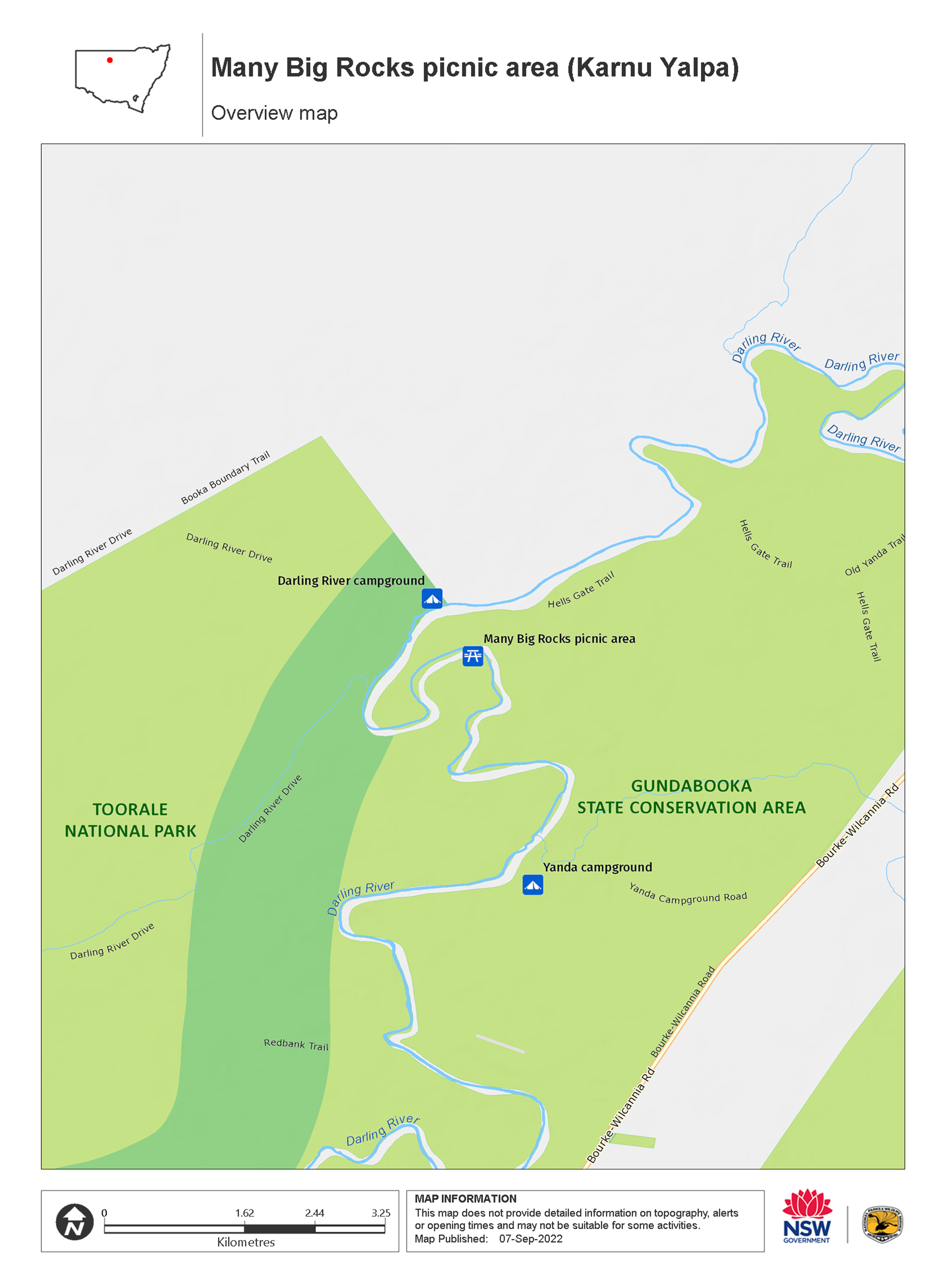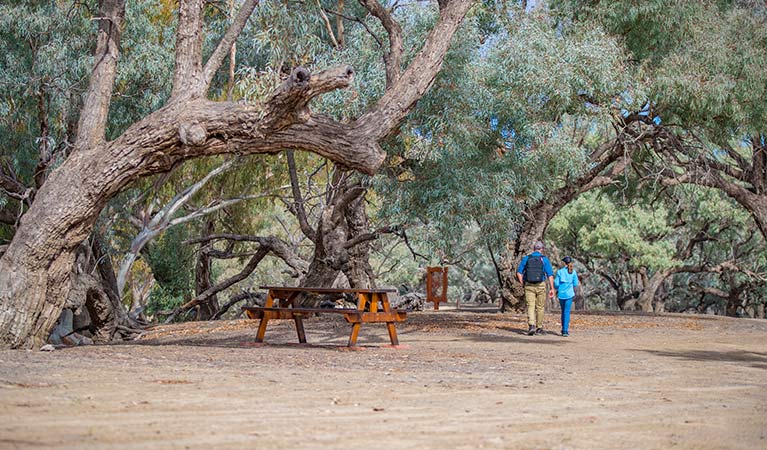Overview
Enjoy an outback picnic at Many Big Rocks picnic area (Karnu Yalpa) in Toorale National Park, near Bourke. You can also birdwatch or fish by the banks of the Darling River, under a shady coolibah tree.
- Type
- Picnic areas
- Where
- Toorale National Park in Outback NSW
- Accessibility
- Medium
- What to
bring - Hat, sunscreen, snacks, drinking water, sturdy shoes, suitable clothing, clothes for all weather conditions, insect repellent
- Please note
- This is a remote picnic area with no water facilities, please arrive well prepared.
- It's a good idea to pick up maps and brochures from the NPWS Bourke office or Bourke Visitor Information Centre. You may want to bring a topographic map, compass or GPS.
- The weather in this area can be extreme and unpredictable. Check conditions and closures before you set out.
- Please respect the wishes of the Kurnu-Baakandji People by protecting the natural and cultural features of the park.
Many Big Rocks picnic area (Karnu Yalpa) is a tranquil stop along the Darling River driving route. Enjoy a picnic lunch by a bend in the river, under the coolibah trees and river red gums. Spend some time fishing from the riverbank or natural rock weir to see if the yellow belly or cod are biting.
Stretch your legs with a walk along the water's edge to catch a glimpse of waterbirds like cormorants and spoonbills. Chances are you'll also spot emus, kangaroos bouncing around, or a wedge-tailed eagle soaring above.
After your break, you'll be ready to continue exploring Toorale National Park. Visit Toorale Homestead to see the outback's pastoral history, or learn about the Kurnu-Baakandji People and their strong connection to these lands. At Mount Talowla lookout you'll be greeted with vast outback views of the floodplains, and seasonal wildflowers, stretching towards Mount Gunderbooka.
At the end of the day, the basic Darling River campground (Yapara Paaka Thuru) is located 500m from the picnic area. You can also camp, or stay at an old homestead or shearer's quarters, in Gundabooka National Park.
The best times to visit are during the cooler months, between April and September.
Map

Map legend

Local alerts
For the latest updates on fires, closures and other alerts in this area, see https://www.nationalparks.nsw.gov.au/things-to-do/picnic-areas/many-big-rocks-picnic-area/local-alerts
General enquiries
- National Parks Contact Centre
- 7am to 7pm daily
- 1300 072 757 (13000 PARKS) for the cost of a local call within Australia excluding mobiles
- parks.info@environment.nsw.gov.au
Park info
- in Toorale National Park in the Outback NSW region
Toorale National Park and SCA is always open, but may have to close at times due to poor weather or fire danger.
Visitor info
All the practical information you need to know about the Many Big Rocks picnic area (Karnu Yalpa).
Getting there and parking
Many Big Rocks picnic area is in Toorale National Park. To get there:
From Bourke:
- Travel 10km north along Hungerford Road, then turn left onto Wanaaring Road.
- Drive 22km then turn left onto Toorale Road, which is unsealed.
- Travel 38km to the entrance of Toorale National Park, and continue for 1.5km.
- Travel 38km to the entrance of Toorale National Park.
- Around 1.5km past the park entrance turn left at the Darling River Drive sign.
- Follow the signs along Darling River Drive for 18km, until you reach Many Big Rocks picnic area.
From Louth:
- Cross the bridge heading west and travel 2km, then turn right at the Tilpa sign.
- Travel 25km on the unsealed Toorale Road. After crossing the stock grid, you’ll see the entrance to Toorale National Park.
- Continue 28.5km on Toorale Road and turn right at the Darling River Drive sign.
- Follow the signs along Darling River Drive for 18km, until you reach Many Big Rocks picnic area.
Road quality
Roads to and within Toorale National Park are unsealed and can be closed due to wet weather. Check with the NPWS Bourke office or Bourke Shire Council for the latest road conditions before you set out. Don’t drive on closed roads – heavy fines apply.
- Unsealed roads
Vehicle access
- 2WD vehicles
Weather restrictions
- Dry weather only
Parking
Parking is available in a natural earth carpark at Many Big Rocks picnic area.
Facilities
- Water is not available, so make sure you bring plenty of drinking water for your stay.
- Rubbish bins are not provided. Please take your rubbish with you when you leave.
Toilets
There's a single non-flush toilet at the picnic area.
- Non-flush toilets
Picnic tables
Carpark
Step-free access
There is step-free access around the picnic area, but there are no pathways. You'll need to cross over unsealed hard-packed ground to reach the facilities.
Some of the ground is uneven and steeply sloped as you approach the river.
Maps and downloads
Accessibility
Disability access level - medium
Many Big Rocks picnic area is mostly flat and step-free but there are no pathways. You'll need to cross over unsealed hard-packed ground to reach the facilities.
Assistance may be required in the following areas:
- The toilet at the picnic area is not accessible or ambulant.
- Some of the ground is uneven and steeply sloped as you approach the river.
Permitted
Fishing
A current NSW recreational fishing licence is required when fishing in all waters.
Prohibited
Camp fires and solid fuel burners
Camping
You can camp at the basic Darling River campground (Yapara Paaka Thuru), located 500m from the picnic area.
Pets
Pets and domestic animals (other than certified assistance animals) are not permitted. Find out which regional parks allow dog walking and see the pets in parks policy for more information.
Smoking
NSW national parks are no smoking areas.
Learn more
Many Big Rocks picnic area (Karnu Yalpa) is in Toorale National Park. Here are just some of the reasons why this park is special:
Birdwatching spectacular

After the rains, the vast natural floodplain springs to life and the wetlands bring an abundance of birdlife. A fabulous spot for birdwatching, bring your binoculars for the chance to see the iconic brolga, pink cockatoo, or the wide range of waterbirds such as the Australian pelican, pied cormorant and royal spoonbill.
Inland rivers

Toorale National Park marks the junction of two mighty inland rivers and provides one of only a few opportunities to access the Darling and Warrego rivers. Set up camp on the Darling riverbank, or spend a leisurely day checking out the local wildlife, birdwatching and fishing.
Rich pastoral history

A relative newcomer to the national park family, Toorale was purchased in 2008. The large pastoral station and woolshed changed hands many times, and many people have a historic connection to Toorale, including Henry Lawson, who worked on the station for a short period during the 1890s.
- Toorale Homestead precinct (Yarramarra) Toorale Homestead precinct (Yarramarra) is a must-see for outback travellers near Bourke. Built on the lands of the Kurnu-Baakandji People, Toorale Station was once part of the world’s largest sheep station.
The People of Darling River

This country between the Warrego and Darling rivers is of spiritual and cultural significance to Kurnu-Baakandji People. The name Baakandji comes from the word ‘paaka’, meaning ‘Darling River’, so Baakandji are the People belonging to Darling River. Take a Discovery tour to learn about the culture and heritage of the region as well as local bush tucker such as wild orange, quandongs, wild plum bush, wild bananas and bush tomatoes.

